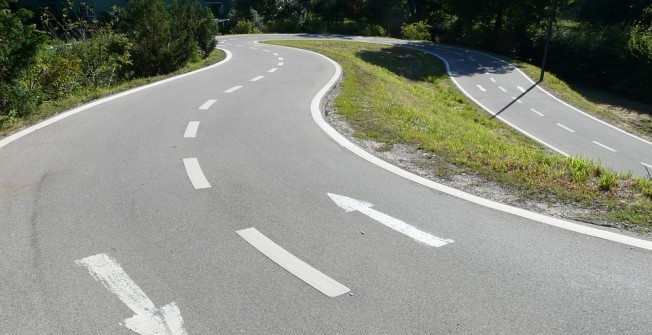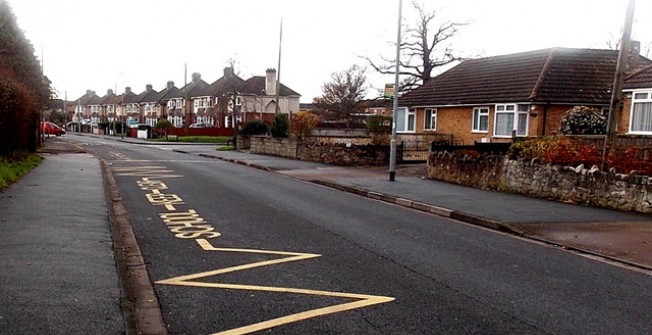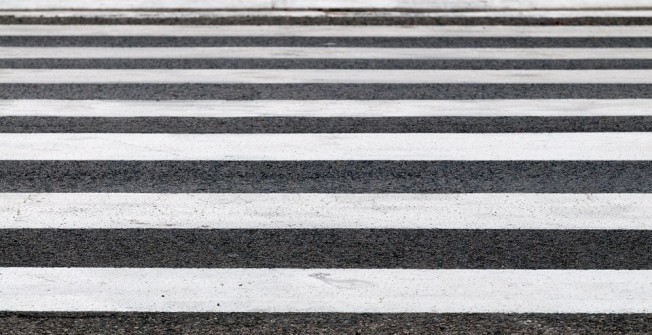Road Line Marking in Abergwynfi
Our specialists can carry out road line marking in Abergwynfi SA13 3 to mark out different lanes and make important information clear to drivers and pedestrians.
Lines for roads are available in different colours and sizes; each of these will have a specific meaning which drivers will be required to understand.
Our installers can apply many road marking lines to roads across the United Kingdom. It is vital that the lining is clear to drivers to ensure that no accidents occur; if you require relining of roadway markings, our team can offer assistance at affordable prices.
We have worked within the road marking industry for many years and we only make use of premium materials. Our main goal is to produce high quality line marking which will last a long time.
Our nearby professionals take care when installing the markings to make sure they are applied in the correct place.
We understand that if the thermoplastics are not installed with accuracy, collisions could be caused; this is why it is important to get a professional line marker team to install the road line markings.
For more information on our services and the costs of the line marking service, please send us your details using the enquiry form on this page.
GET A QUOTE
Types of Road Line Markings
Road line markings are essential for guiding traffic, improving road safety, and ensuring efficient traffic flow. These markings come in various types and play specific roles in road management. Here are some common types of road line markings:
- Centre Lines: The centre line divides opposing lanes of traffic and indicates no-passing zones. It helps prevent head-on collisions and guides drivers in maintaining their lane.
- Edge Line: Edge lines are painted along the sides of the road to help drivers stay within the travel lane and provide a visual boundary.
- Lane Line: Lane lines separate traffic lanes on multilane roads and highways. They include solid lines for no lane changes and dashed lines for permissible lane changes.
- Double Solid Line: A double solid line indicates that drivers are not allowed to cross the line to change lanes or pass other vehicles.
- Dashed Line: Dashed lines indicate that drivers are allowed to cross them to change lanes or pass other vehicles if it's safe to do so.
- Broken Centre Lines: A broken centre line indicates that passing is allowed on one side of the road but not on the other. It is typically used on roads with multiple lanes in one direction and a single lane in the opposite direction.
- Stop Line: A stop line is painted before intersections and stop signs, indicating where vehicles should come to a complete stop.
- Yield Line: A yield line is used at yield signs and indicates where drivers should yield to other traffic.
- Crosswalk: Crosswalk markings indicate pedestrian crossing points and help drivers recognise areas where pedestrians may be crossing.
- Zebra Crossing: A zebra crossing consists of alternating black and white stripes to designate a pedestrian crossing area. It emphasizes pedestrian right of way.
- Bicycle Lane: Bicycle lane markings designate lanes reserved for cyclists and provide a safe space for bicycle traffic.
- Turn Arrows: Turn arrows indicate the direction of permissible turns, including left turns, right turns, and U-turns.
- Shared Lane Markings (Sharrows): Sharrows are painted symbols that indicate shared lanes for both bicycles and motor vehicles. They are used in areas where bicycles and vehicles share the road.
- Pedestrian Islands: Pedestrian islands in the middle of the road can be marked to indicate a safe refuge for pedestrians crossing multi-lane roads.
- Text and Symbols: Road markings may include text messages, such as "STOP," "SLOW," or "SCHOOL ZONE," as well as symbols that convey specific messages to drivers.
- Bus Lane Markings: These markings designate lanes reserved for buses, encouraging efficient public transportation.
- Parking Space Lines: In parking lots, road markings are used to define individual parking spaces and indicate driving lanes
Yellow Lines on Road
In the UK, yellow lines on the road have specific meanings and purposes, which are consistent with road markings used in many other countries. Here's a breakdown of the common yellow lines used on roads in the UK and their meanings:
- Single Yellow Lines: Single yellow lines indicate that parking is restricted during certain times. The specific times and days of restriction are usually indicated on nearby signs. Outside the restricted hours, parking may be allowed, but drivers should always check for additional signs and information.
- Double Yellow Lines: Double yellow lines generally indicate a more stringent parking restriction. Parking is often prohibited at all times on double yellow lines. Exceptions may exist, such as loading or unloading for a limited time, as indicated by nearby signs.
- Yellow Zigzag Lines: Yellow zigzag lines are commonly used near pedestrian crossings and schools. Parking, waiting, or stopping is typically prohibited on or near yellow zigzag lines to enhance pedestrian safety and visibility. Special rules usually apply, and drivers are advised not to park or stop in these areas.
CONTACT US TODAY
White Lines on Roads Near Me
White lines on roads serve as important road markings that convey specific information to drivers. These lines are used for various purposes, including indicating road boundaries, guiding traffic, and providing information about the rules of the road. Here are some common types of white lines found on roads in the UK:
-
Centre Line: A single continuous white line in the center of the road indicates a two-way road. It helps drivers stay in their lanes and separates traffic moving in opposite directions.
-
Lane Division Lines: Broken white lines separate lanes of traffic moving in the same direction. Drivers can change lanes when it is safe to do so. Solid white lines indicate that changing lanes is discouraged, and drivers should stay in their current lane.
-
Edge Lines: Solid white lines along the edge of the road indicate the boundary of the carriageway. Drivers should not cross these lines except in emergencies.
-
Double White Lines: Double white lines, one solid and one broken, indicate that drivers should not cross the solid line but can cross the broken line to overtake if it is safe.
-
Lane Drop Markings: Diagonal white lines are often used to indicate that a lane is about to merge or drop.
-
Hatched Markings: Hatched markings, which consist of rectangles or squares, are used to separate traffic lanes or indicate areas where stopping or waiting is not allowed.
-
Chevron Markings: Chevron markings consist of white arrow symbols pointing in the direction of the traffic flow. They are often used on slip roads and ramps.
-
Text and Symbols: White lines are used to create text and symbols on the road, conveying information such as speed limits, directional information, and warnings.
-
Reflective Markings: Reflective white lines and road studs (cats eyes) are used to enhance visibility, especially at night.
-
Box Junctions: Box junctions are marked with white crisscross lines. Drivers must not enter the box unless their exit is clear.
These markings are crucial for maintaining order on the roads, guiding traffic, and enhancing safety. Drivers are expected to understand and follow the rules associated with these white lines to ensure safe and efficient travel.
The Highway Code provides comprehensive information on road markings and their meanings in the UK.
If you would like to discuss the different white lining which we install for motorways https://www.markingcontractors.co.uk/road/motorway/neath-port-talbot/abergwynfi/ and roadways in Abergwynfi SA13 3 or you're interested to find out costs, please fill in our contact form.
One of our experts closest to you will get back to you as soon as possible with more information regarding the line-markings which we can install. We may also provide you with a free quotation once we have received your details.
Road Line Marking Costs in Abergwynfi
The average cost for road lines is £850.
The costs for road line marking will vary depending on the scale of the project. When providing costs for this work, we will need to calculate the material and also the labour and then we can provice you with a quote for the works.
Here are some factors that can influence the cost of road line marking:
- Type of Marking: Different types of road line markings have varying costs. Basic lane lines and centre lines may be less expensive than more complex markings like intersections, crosswalks, and symbols.
- Length and Complexity: The longer the road or the more complex the layout (such as multiple lanes, turns, and intersections), the higher the installation costs may be.
- Materials Used: The cost of materials plays a significant role. Reflective materials, glass beads for improved nighttime visibility, and specialised road line marking paint or thermoplastic materials can affect costs.
- Road Conditions: The condition of the road surface can impact the preparation work required before applying line markings. If the road needs cleaning, repairing, or resurfacing, additional costs may be incurred.
- Location and Accessibility: Markings in high-traffic urban areas may have higher installation costs due to increased traffic management efforts and safety precautions.
- Labour Costs: Labor costs include the wages of skilled workers involved in the application of road line markings. Complex markings or layouts may require more time and labour.
- Traffic Control: For some road line marking projects, traffic control measures may be needed to ensure the safety of workers and road users. This can add to the overall cost.
- Material Quality: Using higher-quality materials, such as reflective paint or durable thermoplastic, may increase initial costs but can result in longer-lasting markings, potentially reducing long-term maintenance costs.
- Regulatory Compliance: Some regions have specific regulations and standards for road markings. Ensuring compliance with these standards may impact costs.
- Long-Term Maintenance: While high-quality markings can last longer and reduce the need for frequent repainting, there will still be maintenance costs over time to keep the markings clear and visible.
Road Line Marking Benefits
Road line markings play a crucial role in road safety, traffic management, and overall road infrastructure. They provide a range of benefits that contribute to efficient traffic flow and reduced accident rates. Here are some key benefits of road line markings:
- Guidance and Direction: Line markings provide clear guidance to drivers, helping them stay within lanes, make proper turns, and navigate intersections safely.
- Lane Discipline: Line markings help maintain lane discipline, preventing lane drifting and reducing the risk of collisions due to improper lane changes.
- Traffic Flow: Well-marked lanes and intersections improve traffic flow by minimising confusion and preventing congestion caused by lane-changing conflicts.
- Preventing Collisions: Centre lines prevent head-on collisions by clearly separating opposing lanes of traffic.
- Reduced Overtaking Conflicts: Line markings indicate no-passing zones and help prevent dangerous overtaking manoeuvres.
- Pedestrian Safety: Crosswalk and zebra crossing markings enhance pedestrian safety by clearly indicating safe crossing points.
- Bicycle Safety: Bicycle lane markings designate areas where cyclists can safely travel, reducing conflicts between bicycles and motor vehicles.
- Visual Cues: Line markings provide visual cues that help drivers anticipate curves, turns, and intersections ahead.
- Intersection Safety: Stop lines and yield lines at intersections remind drivers to come to a stop or yield to other traffic, reducing the risk of collisions.
- Road Hierarchy: Different types of line markings, such as dashed and solid lines, indicate road hierarchy and priority for specific lanes or movements.
- Night Visibility: Reflective materials and glass beads embedded in line markings enhance visibility at night when illuminated by vehicle headlights.
- Traffic Calming: Line markings can be used to create traffic calming measures like speed humps, chicanes, and roundabouts.
- Pedestrian Safety: Line markings on pedestrian islands provide clear visual cues to drivers to yield to pedestrians in crosswalks.
- Consistency: Uniform and consistent line markings across roadways provide a standardised visual language for drivers, regardless of location.
- Public Transport Efficiency: Bus lane markings designate lanes reserved for buses, improving public transport efficiency and reducing congestion.
- Accessibility: Road line markings help visually impaired pedestrians navigate intersections and crossings.
- Alerting Hazards: Markings can highlight hazards such as construction zones, railway crossings, and pedestrian crossings.
- Parking Efficiency: Car parks bay markings define parking spaces and lanes, optimising parking efficiency and preventing congestion.
- Communication: Line markings convey important information to drivers, helping them make informed decisions and ensuring safe interactions with other road users.
- Driver Confidence: Clear and well-maintained line markings boost driver confidence and reduce stress, leading to safer and more comfortable driving experiences.
Overall, road line markings contribute to a safer and more organised road environment, helping prevent accidents, minimising traffic disruptions, and enhancing the overall transportation system's functionality.
How to Install Roadway Lines
Installing roadway lines involves applying road markings to delineate traffic lanes, guide drivers, and enhance road safety. Proper installation requires careful planning, attention to detail, and adherence to safety regulations. Here's a general guide on how to install roadway lines:
- Plan and Design
- Gather Materials and Equipment
- Prepare the Surface
- Apply Primer (If Needed)
- Set Up Traffic Control Measures
- Mark the Layout
- Apply Road Markings
- Reflective Glass Beads (Optional)
- Add Symbols and Details
- Allow Drying/Curing Time
- Clean Up
- Safety Precautions
- Monitor and Maintenance
Road Lining Maintenance in Abergwynfi
It is crucial to get linings which have been applied to roads touched up when they have become worn out; this is because roadways can become dangerous if drivers cannot see the line-markings and it becomes a health and safety risk.
Our specialists can carry out relining services to renew existing markings and make them more visible to drivers and pedestrians. Road lining maintenance is important to ensure no accidents are caused.
If a stop line or give way signs become worn out, people may not stop at busy junctions; similarly if lane line-markings become unclear, people may accidentally switch lanes and cause a collision.
High friction surfacing https://www.markingcontractors.co.uk/surfaces/high-friction/neath-port-talbot/abergwynfi/ will also need to be maintained. For details on maintenance, please complete our contact form.
What are Road Line Markings?
Road lines are used to indicate lanes, turns and many other control measures.
These markings are crucial to provide road safety for all users. They indicate where vehicles should be positioned, provide guidance and show potential hazards to road users.
Line road marking is the application of thermoplastics or paints onto road surfaces, tarmac, asphalt, concrete or pavements.
GET IN TOUCH TODAY
Frequently Asked Questions
What Materials are Used to Create Road Line Markings?
The materials which are used to create road lines is paint or thermoplastic.
The material will include reflective properties to make them visible at night and in poor weather conditions.
Using materials which include reflectivity properties are important for the visibility of the lines.
How Long do Road Lines Typically Last?
These line markings tend to last between 3-5 years.
There are various factors which can impact the lifepan of the lines and these include the traffic volume / amount of usage and the weather conditions.
They are not permanent but long lasting and durable.
How is the Road Surface Prepared Before Line Marking?
Before any paint is applied to the road, the surface should be cleaned and free from any debris and dirt.
It is recommended to power wash the area to prepare it and then fix any cracks or potholes in the surface.
How Wide are the White Lines on Road?
A standard white line usually has the width of 100-150mm wide.
How is a Cycle Lane Marked?
A bicycle lane is separated from traffic with a solid or dashed line.
The start of a cycle lane is marked by a sign, usually a bicycle outline or wording.
ENQUIRE TODAY FOR THE BEST RATES
Other Markings We Offer
Contact Us
We conduct line road markings in Abergwynfi SA13 3 to improve the safety of people on the roads. Fill in our contact form to speak to one of our advisors.
Once we have information on your project, we can provide you with information on the products we recommend and offer advice for any of your projects.
Searches Associated with Road Line Marking
- Road Line Marking Installers in Abergwynfi
- Voted Best Road Line Marking Company
- Abergwynfi Road Line Marking Contractors
- Best Abergwynfi Road Line Marking Companies
- Road Line Marking Near Me
- Line Marking for Car Parks in Abergwynfi
- Road Line Marking Paint
- Double Yellow Lines
- Single Yellow Lines
- Double White Lines
- Solid White Line
- Broken White Lines
- Broken White Line
- UK Road Markings


